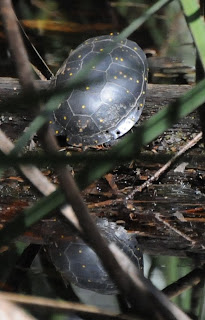

Looking at the first two images, we can determine that the turtle was part of Dr. Litzgus' study. The two holes in the lower right rear of the carapace were drilled to hold the radio transmitter. The drilled holes along with the identifying notch cut in the lower left rear of the carapace do not cause any harm to the turtle. By tracking the turtles, Dr. Litzgus learned that the human changes to the environment (powerline) and the natural changes to the environment (Hurricane Hugo) actually benefited the Spotted Turtle at Beidler Forest. The powerline clearing offered ample sun, not found under the canopy in the swamp, for basking and the hurricane-felled trees provided pools of water where the roots pulled out and nesting sites as the trunks rotted. Unfortunately, habitat loss and collection for the pet trade remain serious threats to Spotted Turtle populations.

Turtles are aggregating now to mate, so it should be fairly easy to catch a glimpse of this species. They currently have one-track minds.
Images by Mark Musselman
2 comments:
Hello, I'm Vicente from testudines.org in Spain, Wanderful pictures.
Please, could you give to us publicsh your pictures in testudines.org in a of Spotted Turtle sheet.
The page are in http://www.testudines.org/Articulos/Ficha-de-Especie/Clemmys-guttata-SCHNEIDER,-1792.aspx
Of course we put in picture your credential.
Best regards
Of course. Contact Mark Musselman at http://sc.audubon.org/AboutUs_ContactUs_Staff.html
Post a Comment